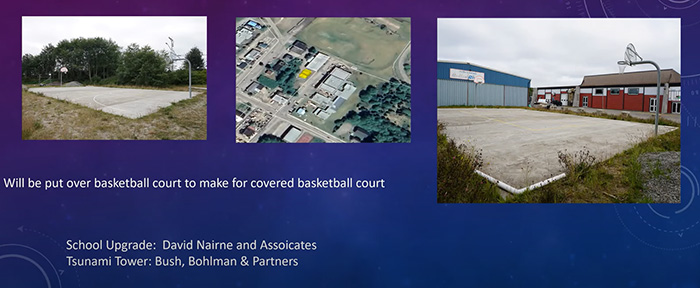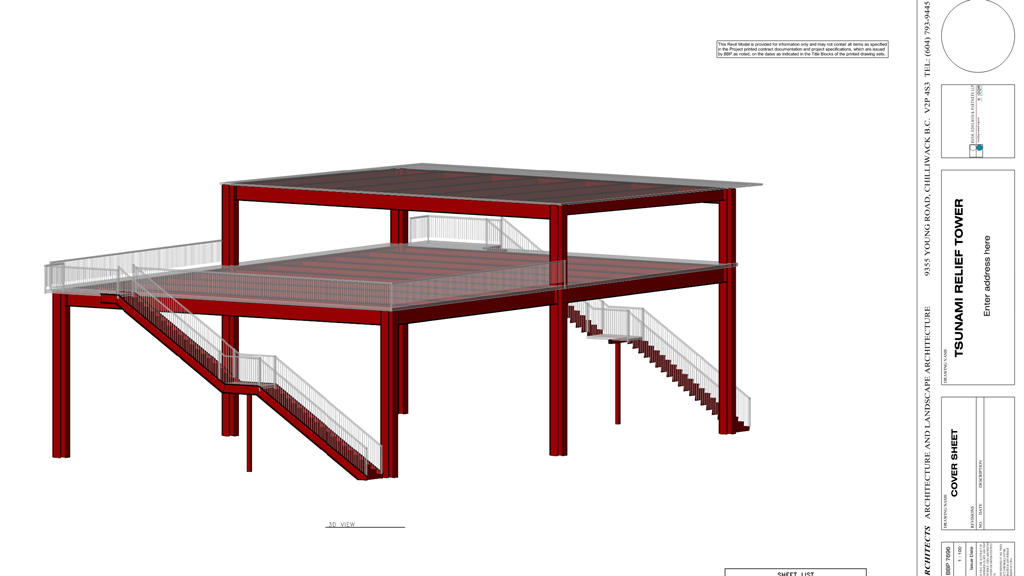Canada’s first tsunami evacuation tower in the community of Masset, B.C. is an example of how structural steel can literally be a lifesaver.
The tower is located on the property of Gudangaay Tlaat’sa Naay Secondary School in Haida Gwaii and the hope is it will be used to keep students safe from a massive wave following an earthquake.
“It’s located quite remote…about 800 kilometres by air north of Vancouver,” said Andy Metten, partner at Bush, Bohlman & Partners LLP, during a presentation at the Canadian Institute for Steel Construction’s recent conference. “That had quite an influence on how we designed the project and how we thought about it.
“We spend a lot of time designing for earthquakes in Canada and from a life safety point of view it’s paramount, but more people have died in tsunamis in Canada than have died from structural failures in earthquakes.”
The current tsunami risk and protocols for Masset says in the event of an earthquake people should drive through the tsunami zone. It often takes about 40 minutes to get to higher ground.
“The speed (of a tsunami) is a significant hazard,” Metten said. “It doesn’t have to be a huge wave like the Hollywood movies, but you are getting a flow of water that is very dangerous.”
How high do you need to build a tsunami tower to get people to safety?

“The tsunami safe zone is about 10 metres above high tide,” said Metten. “We built it over a basketball court and the advantage is you need to have a sufficient height for people to play basketball there.”
Japan has a number of purpose-built vertical evacuation tsunami towers and they are a proven means of protection.
“They’re all steel and they’re all galvanized, a lot of them are open structures,” he pointed out. “The intent is that you wouldn’t be spending a lot of time up there…The waves kind of wash underneath you and then you’re going to be safe.”
The tower was done as part of a school upgrade and it was an important part of the school’s seismic mitigation.
In terms of design considerations, seismic protection was at the top of the list. Metten said the American Institute of Steel Construction and the American Society of Civil Engineers have a lot of material on how to design for a tsunami.
“We used a seismic design steel frame, bolted connections,” said Metten. “We had three lines of resistance in one direction and two lines in the other. We did end bolted moment connections which are easy to fabricate and you’re doing all your fabrication in a fabrication shop (that’s) warm and dry and where there is a good supply of labour.”
Because there were intersecting lines of resistance the team chose to go with cruciform columns.
They also decided to streamline the columns by adding bent plates and filling it with concrete.
“The aim was partly to make it less hazardous for people around the basketball court but also to make it less likely for debris to get caught in the cruciform columns that might cause some undesirable loads,” Metten said. “We reduced onsite welding. We were very careful to try and do all of our connections by bolting.
“There are several reasons for that. One is that it’s hard to get people up to do the welding and then you’ve got to inspect it.”
One of the questions he is often asked is how many people can it hold.
“The platform is a concrete slab,” said Metten. “It is 400 square metres. You could put up to 400 people from basically a size point of view.”
Corrosion protection was a really important factor for the owner.
“The site is surrounded by water,” said Metten. “We wanted to make it durable to start with rather than try to fix it later.”
There were two options for finish on the structural steel: high performance epoxy paint and galvanizing.
“The general contractor looked at it and basically said the costs were very similar, especially when we considered the need for touch up paint on epoxy,” said Metten.
The deck design used a flat soffit slab.
“It’s similar to the way many bridges are designed,” Metten explained. “You have galvanized steel beams supporting a flat soffit concrete deck.”
Before the project began, Metten visited Haida Gwaii and spoke to the school board about a proposal on the tower.
“He said, ‘What I really need is a conceptual design and a conceptual scheme,’” said Metten. “We wound up with about 10 pages of drawings and a concept scheme…At the end of conceptual design to what we had at the end of working drawings was a very similar looking structure, not a huge amount of change. The stairs had gone to concrete at the bottom as opposed to being just open steel and we wound up starting the construction.”
Construction began in summer 2021 and was completed in fall of 2022.
“One of the joys of structural steel, and especially if you’re using end bolted moment connections, is things do go up very quickly and it’s independent of weather,” Metten said.
Follow the author on Twitter @DCN_Angela.











Recent Comments